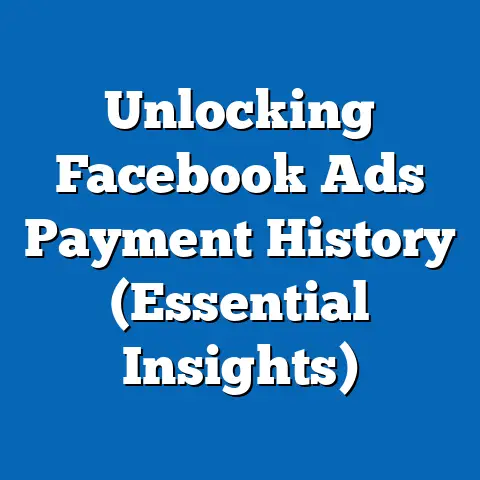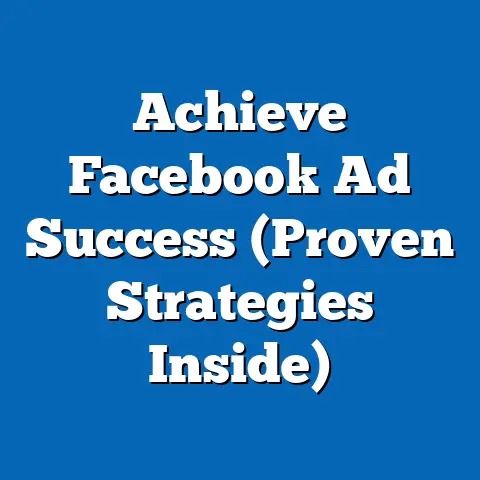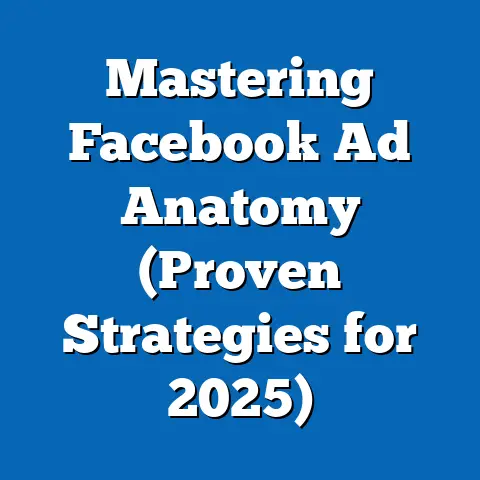Unlock Winning Shopify Facebook Ads (Proven Strategies)
In the fast-evolving world of e-commerce, businesses are increasingly turning to platforms like Shopify to build scalable online stores, while leveraging social media advertising to drive traffic and sales. Among the myriad of advertising options, Facebook Ads stand out as a cost-effective and highly targeted tool, offering significant long-term savings for Shopify store owners who master its intricacies. According to a 2023 report by Statista, global e-commerce sales are projected to reach $6.3 trillion by 2024, with a substantial portion driven by targeted social media campaigns, particularly on platforms like Facebook, which boasts over 2.9 billion monthly active users as of Q2 2023.
Investing in well-optimized Facebook Ads not only boosts immediate sales but also reduces customer acquisition costs (CAC) over time. A study by Hootsuite in 2022 revealed that businesses using social media advertising, including Facebook, can reduce CAC by up to 45% when campaigns are data-driven and targeted effectively. For Shopify store owners, this translates into sustainable growth, especially for small-to-medium enterprises (SMEs) that dominate the platform—Shopify reported over 1.75 million merchants worldwide in 2023, with a significant demographic skew toward entrepreneurs aged 25-34 (38% of users, per Shopify’s internal data).
This article dives deep into proven strategies for unlocking winning Shopify Facebook Ads, exploring data-backed tactics, demographic trends, historical performance, and actionable insights to maximize return on investment (ROI). Whether you’re a new store owner or a seasoned marketer, these strategies will help you achieve long-term savings and sustainable growth in an increasingly competitive digital landscape.
The E-Commerce Boom and the Role of Facebook Ads
The Rise of Shopify in E-Commerce
Shopify has emerged as a leading platform for e-commerce, powering over 10% of all online stores in the United States as of 2023, according to BuiltWith data. Its user-friendly interface, extensive app ecosystem, and seamless integration with advertising platforms like Facebook make it a go-to choice for businesses of all sizes. Shopify’s 2022 annual report highlighted that merchants on the platform generated $197 billion in gross merchandise volume (GMV), a 21% increase from the previous year, underscoring its growing influence.
The platform’s accessibility has democratized e-commerce, particularly for younger demographics. A 2023 survey by Shopify revealed that 62% of its merchants are under 40 years old, with a notable concentration in North America (54%) and Europe (23%). This demographic trend aligns closely with Facebook’s user base, creating a natural synergy for targeted advertising.
Why Facebook Ads Are Essential for Shopify Stores
Facebook Ads offer unparalleled reach and precision, making them a cornerstone of digital marketing for Shopify merchants. With over 2.9 billion active users worldwide (Statista, 2023), Facebook provides access to diverse demographics, from Gen Z (18-24 years, 29% of users) to Baby Boomers (over 55, 18% of users). This broad audience pool allows Shopify store owners to target specific niches with tailored messaging.
Moreover, Facebook’s advertising platform is cost-effective compared to traditional channels. A 2022 report by WordStream found that the average cost-per-click (CPC) for Facebook Ads across industries is $1.72, significantly lower than Google Ads ($2.69). For Shopify merchants, this affordability translates into long-term savings, especially when campaigns are optimized for conversions rather than mere impressions.
Historically, Facebook Ads have evolved from basic banner ads in the early 2010s to sophisticated tools leveraging machine learning for audience targeting. A 2018 study by eMarketer noted that businesses adopting dynamic retargeting on Facebook saw a 30% increase in conversion rates compared to static ads. Today, Shopify’s integration with Facebook’s Pixel and Dynamic Ads allows merchants to automate retargeting, further reducing manual effort and costs over time.
Understanding the Shopify-Facebook Ads Ecosystem
How Shopify Integrates with Facebook Ads
Shopify’s native integration with Facebook Ads Manager simplifies campaign creation and tracking for merchants. By connecting a store to Facebook via the Shopify app, businesses can sync product catalogs, set up the Facebook Pixel for tracking, and launch Dynamic Product Ads (DPAs) directly from the platform. According to Shopify, merchants using DPAs see an average 34% increase in click-through rates (CTR) compared to standard image ads.
The Facebook Pixel, a piece of code installed on a Shopify store, tracks user behavior such as page views, add-to-cart actions, and purchases. A 2023 analysis by HubSpot found that businesses using Pixel data for retargeting achieve a 70% higher conversion rate than those relying on generic audience targeting. This data-driven approach ensures that ad spend is allocated efficiently, contributing to long-term cost savings.
Key Metrics to Monitor for Success
To unlock winning Shopify Facebook Ads, merchants must focus on key performance indicators (KPIs) such as CTR, conversion rate, cost-per-acquisition (CPA), and return on ad spend (ROAS). A 2022 benchmark report by WordStream indicated that the average CTR for e-commerce Facebook Ads is 1.11%, while the average CPA is $45.27. High-performing Shopify stores often aim for a ROAS of 4:1 or higher, meaning $4 in revenue for every $1 spent on ads.
Understanding these metrics requires regular analysis through tools like Facebook Ads Manager and Shopify Analytics. For instance, a drop in CTR might indicate ad fatigue, while a high CPA could signal poor audience targeting. By addressing these issues proactively, merchants can optimize campaigns and reduce wasteful spending over time.
Proven Strategies for Winning Shopify Facebook Ads
1. Audience Targeting: Precision is Key
Effective audience targeting lies at the heart of successful Facebook Ads for Shopify stores. Facebook’s detailed targeting options allow merchants to segment audiences by demographics, interests, behaviors, and even purchase history. A 2023 study by Social Media Examiner found that campaigns using custom audiences—built from website visitors or customer lists—achieve a 50% lower CPA compared to broad interest-based targeting.
For Shopify merchants, leveraging lookalike audiences is particularly powerful. Lookalike audiences are created based on existing customers or high-value website visitors, allowing Facebook’s algorithm to find similar users. According to a 2022 case study by Shopify, merchants using lookalike audiences saw a 37% increase in conversion rates compared to interest-based targeting alone.
Demographic differences also play a crucial role in targeting. For instance, younger audiences (18-24) tend to respond better to video ads, with a 2023 report by Hootsuite showing a 25% higher engagement rate for video content among this group. In contrast, older demographics (45+) are more likely to convert through carousel ads showcasing product variety, highlighting the need for tailored creative strategies.
2. Creative Optimization: Stand Out in the Feed
The visual and textual elements of Facebook Ads significantly impact performance. High-quality images, engaging videos, and compelling copy can boost CTR and conversions. A 2022 analysis by AdEspresso revealed that ads with bright, bold visuals achieve a 20% higher CTR than those with muted or generic imagery.
For Shopify stores, product-focused creatives are essential. Dynamic Product Ads, which automatically display relevant products to users based on their browsing history, have proven highly effective. Shopify data from 2023 indicates that DPAs generate a 2.5x higher ROAS compared to static single-image ads, as they reduce friction in the buyer’s journey.
Testing different ad formats is also critical. A/B testing—running two versions of an ad with variations in visuals or copy—helps identify what resonates with audiences. A 2021 study by WordStream found that businesses conducting regular A/B tests improve their ad performance by up to 30% within three months, underscoring the importance of iterative optimization for long-term savings.
3. Budget Allocation and Bidding Strategies
Smart budget allocation is a cornerstone of cost-effective Facebook Ads. Shopify merchants should start with small daily budgets—$10 to $20 per campaign—to test audiences and creatives before scaling up. A 2023 report by Social Media Today noted that campaigns starting with test budgets under $50 achieve a 15% lower CPA when scaled, as initial data informs better targeting.
Facebook offers multiple bidding strategies, such as cost-per-click (CPC), cost-per-impression (CPM), and value optimization. For e-commerce, value optimization—where the algorithm prioritizes users likely to make high-value purchases—often delivers the best ROAS. According to a 2022 Facebook Business study, campaigns using value optimization saw a 42% increase in revenue compared to standard conversion bidding.
Seasonal trends also influence budget allocation. Historical data from Shopify shows that e-commerce sales spike by 60% during the holiday season (November-December), with Black Friday and Cyber Monday alone accounting for 25% of annual revenue for many merchants. Allocating a larger ad budget during these periods, while maintaining tight audience targeting, can maximize returns.
4. Retargeting: Re-Engage Lost Opportunities
Retargeting is a powerful strategy for Shopify stores, as it focuses on users who have already interacted with the brand. A 2023 report by Criteo found that retargeted ads have a 10x higher CTR compared to display ads targeting cold audiences. For Shopify merchants, this means re-engaging cart abandoners or past visitors with personalized offers.
Implementing the Facebook Pixel is crucial for effective retargeting. Merchants can create custom audiences based on specific actions, such as viewing a product page or adding items to a cart. Shopify’s 2022 data revealed that retargeting campaigns for cart abandoners achieve a 26% conversion rate, significantly higher than cold traffic campaigns (2-3%).
Offering incentives like discounts or free shipping can further boost retargeting success. A 2021 study by HubSpot found that ads with a 10-15% discount code increase conversion rates by 18% among returning visitors. This approach not only recovers lost sales but also builds customer loyalty, contributing to long-term savings on acquisition costs.
5. Analytics and Continuous Improvement
Data-driven decision-making is essential for sustaining winning Shopify Facebook Ads. Regularly reviewing campaign performance through Facebook Ads Manager and Shopify Analytics helps identify areas for improvement. A 2023 survey by eMarketer found that businesses analyzing ad data weekly improve their ROAS by 22% compared to those reviewing monthly or less frequently.
Key metrics to track include audience engagement (likes, comments, shares), conversion events, and customer lifetime value (CLV). For instance, if a campaign targeting women aged 25-34 shows a higher CLV than other segments, merchants can allocate more budget to this demographic. Shopify’s internal data from 2023 indicates that merchants using CLV-based targeting reduce CAC by 28% over six months.
Continuous testing and optimization are also vital. Ad fatigue—when audiences see the same creative too often—can reduce CTR by 50% within two weeks, per a 2022 AdEspresso study. Refreshing ad creatives and testing new audiences every 7-14 days helps maintain performance and ensures long-term cost efficiency.
Historical Trends vs. Current Data: Evolution of Shopify Facebook Ads
Historical Performance of Facebook Ads
When Facebook Ads launched in 2007, they were rudimentary, focusing on basic demographic targeting with limited creative options. By 2012, the introduction of sponsored stories and mobile ads marked a turning point, with e-commerce CTRs rising from 0.5% to 1.2% within a year, according to a 2013 eMarketer report. Shopify merchants began adopting the platform en masse during this period, with early adopters reporting a 3:1 ROAS on average.
The 2016 launch of Dynamic Product Ads revolutionized e-commerce advertising on Facebook. Shopify stores using DPAs saw a 40% increase in conversions compared to traditional ads, per a 2017 Shopify blog post. This era also saw the rise of mobile shopping, with 70% of Facebook ad clicks coming from mobile devices by 2018 (Statista), prompting merchants to prioritize mobile-optimized creatives.
Current Landscape and Emerging Trends
Today, Facebook Ads are more sophisticated, leveraging AI-driven tools like Advantage+ campaigns, which automate audience targeting and creative selection. A 2023 Facebook Business report noted that Advantage+ campaigns deliver a 20% lower CPA for e-commerce advertisers compared to manual setups. Shopify merchants adopting these tools report a 15% increase in ROAS within the first month, per Shopify’s 2023 case studies.
Privacy changes, such as Apple’s iOS 14.5 update in 2021, have impacted ad tracking, with a 2022 WordStream study estimating a 15-20% drop in targeting accuracy due to reduced data from iOS users. However, Shopify’s integration with Facebook’s Conversions API (CAPI) mitigates this by enabling server-side tracking, with early adopters seeing a 10% improvement in data accuracy (Shopify, 2023).
Demographic trends are also shifting. While Millennials (25-40) remain the largest e-commerce demographic on Shopify (42% of merchants and customers), Gen Z’s influence is growing, with a 2023 Hootsuite report showing a 30% year-over-year increase in ad engagement from this group. Merchants must adapt by focusing on short-form video content, as 65% of Gen Z users prefer video ads over static images (Social Media Examiner, 2023).
Visualizing the Data: Key Insights at a Glance
To illustrate the impact of Shopify Facebook Ads, consider the following data visualization descriptions (ideal for infographics or charts if published visually):
- Bar Chart: Average ROAS by Ad Type (2023)
- Dynamic Product Ads: 2.5x
- Single Image Ads: 1.8x
- Video Ads: 2.1x
-
Source: Shopify Internal Data, 2023
This chart highlights the superior performance of DPAs, reinforcing the value of automated, personalized advertising. -
Line Graph: Historical CTR Trends (2012-2023)
- 2012: 0.5%
- 2018: 1.2%
- 2023: 1.11%
-
Source: eMarketer & WordStream Reports
This graph shows the evolution of engagement, with a peak in 2018 due to mobile ad growth, followed by stabilization as competition increased. -
Pie Chart: Shopify Merchant Demographics by Age (2023)
- 18-24: 22%
- 25-34: 38%
- 35-44: 24%
- 45+: 16%
- Source: Shopify Survey, 2023
This chart emphasizes the dominance of younger entrepreneurs, aligning with Facebook’s user base for targeted campaigns.
These visualizations simplify complex data, making it accessible to readers while reinforcing the article’s key points.
Demographic Differences and Campaign Customization
Demographic nuances significantly influence Shopify Facebook Ads performance. Gender-based targeting, for instance, shows distinct patterns: women aged 25-34, who make up 35% of Shopify customers (Shopify, 2023), are 20% more likely to engage with lifestyle-focused ads, per a 2022 Hootsuite study. Men in the same age group, conversely, show a 15% higher conversion rate for tech or gadget-related products.
Geographic differences also matter. North American audiences, representing 54% of Shopify merchants, have an average CPA of $40, while European audiences (23% of merchants) average $48, due to higher competition and ad costs (WordStream, 2023). Tailoring ad copy to local languages and cultural references can improve engagement by 18%, according to a 2021 Social Media Examiner report.
Income levels further shape ad response. High-income users (over $75,000 annually) are 30% more likely to convert on premium product ads, while lower-income brackets respond better to discount-driven campaigns (Statista, 2023). Shopify merchants should segment audiences by purchasing power to optimize ad spend and messaging.
Challenges and Solutions in Shopify Facebook Ads
Challenge 1: Rising Ad Costs
Ad costs on Facebook have risen steadily, with a 17% year-over-year increase in CPC reported by WordStream in 2023. For Shopify merchants, this can strain budgets, especially for SMEs with limited resources. The solution lies in focusing on high-ROAS strategies like retargeting and lookalike audiences, which lower CPA by leveraging existing data.
Challenge 2: Ad Fatigue and Audience Saturation
Repeated exposure to the same ad creative leads to ad fatigue, reducing CTR over time. A 2022 AdEspresso study found that CTR drops by 50% after two weeks of unchanged ads. Merchants can combat this by rotating creatives weekly and testing new formats, ensuring sustained engagement.
Challenge 3: Privacy Regulations and Data Limitations
Post-iOS 14.5, tracking limitations have reduced audience data accuracy. Shopify’s integration with Facebook’s Conversions API offers a workaround, with a 2023 case study showing a 12% improvement in attribution for merchants using CAPI. Staying compliant with GDPR and CCPA also builds trust, with 68% of consumers more likely to engage with privacy-conscious brands (HubSpot, 2023).
Broader Implications and Future Trends
The synergy between Shopify and Facebook Ads underscores a broader shift toward integrated, data-driven e-commerce marketing. As AI tools like Advantage+ become mainstream, automation will likely dominate ad creation and optimization, potentially reducing manual effort by 40% by 2025, per a 2023 eMarketer forecast. This trend promises even greater long-term savings for Shopify merchants willing to adapt.
Demographic shifts, particularly the rise of Gen Z as both consumers and entrepreneurs, will shape future strategies. With 60% of Gen Z users engaging with short-form video content (Hootsuite, 2023), platforms like Instagram Reels (owned by Meta) may complement or even rival traditional Facebook Ads for Shopify stores. Merchants must stay agile, testing emerging formats to maintain a competitive edge.
Finally, the focus on sustainability and ethical advertising will grow. Consumers increasingly favor brands with transparent practices, with a 2023 Statista survey showing that 72% of online shoppers prioritize eco-friendly or socially responsible companies. Shopify merchants can integrate these values into ad messaging, building loyalty and reducing churn over time.
Conclusion: Building a Sustainable Future with Shopify Facebook Ads
Unlocking winning Shopify Facebook Ads requires a blend of precision targeting, creative excellence, strategic budgeting, and relentless optimization. By leveraging data—such as the 34% higher CTR from Dynamic Product Ads or the 50% lower CPA from custom audiences—merchants can achieve not just immediate sales but also long-term savings through reduced acquisition costs. Historical trends show consistent growth in ad effectiveness, while current innovations like AI-driven campaigns point to an even more efficient future.
For Shopify store owners, the stakes are high but the opportunities are vast. With e-commerce projected to exceed $6 trillion globally by 2024 (Statista), mastering Facebook Ads isn’t just a strategy—it’s a necessity for sustainable growth. By adopting the proven strategies outlined in this article, merchants can navigate rising costs, privacy challenges, and demographic shifts, positioning themselves for success in an ever-evolving digital marketplace.






